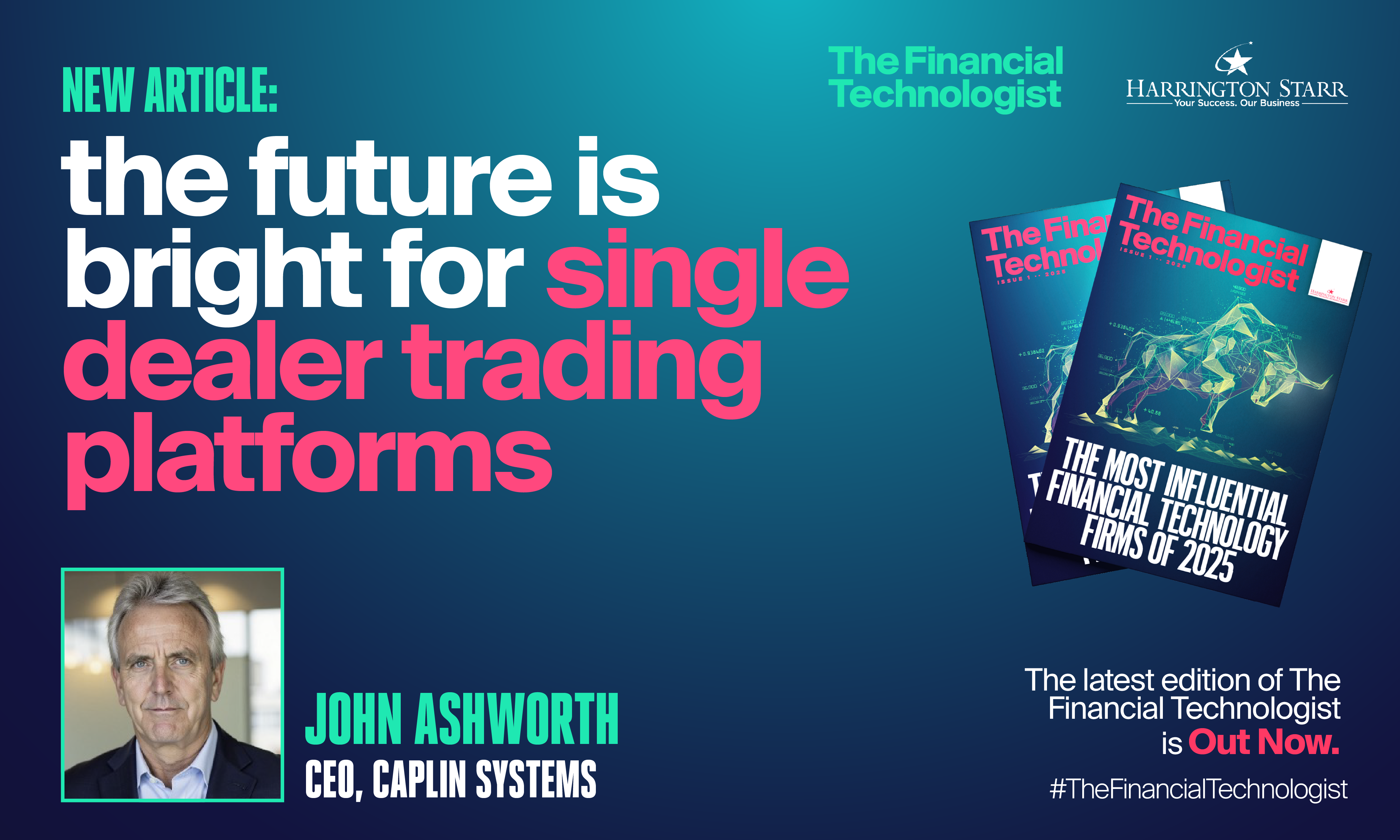Download your free copy of the latest Financial Technologist magazine here.
The electronic trading landscape continues to evolve in line with technological advancements, innovations, and shifting market dynamics. While myriad Multi-Dealer Platforms (MDPs) serve the interbank trading segment, Single Dealer Platforms (SDPs) are increasingly indispensable to banks in terms of delivering trading efficiency and an enhanced customer experience. The right SDP solution can deliver a significant competitive advantage to banks and other liquidity providers in terms of customer loyalty and the ‘stickiness’ of customer relationships.
One of the key drivers of demand and success for today’s SDP solutions is meeting growing demand for multi-asset class trading through one provider. Traditionally, customers have had different relationships and trading channels for FX, equities, fixed income and so on, since these activities were typically siloed by service providers.
Today’s SDP model allows customers to trade multiple asset classes easily through a single platform; supporting more agile, more automated trade execution (for example, leveraging a bank’s algo models), and managing post-trade transaction workflows efficiently through internal and external post trade workflows.
SDP versus MDP: Horses for Courses?
The distinction between SDPs and MDPs is crucial to understanding their respective roles and value proposition in institutional trading. MDPs provide a transparent, centralised venue bringing together multiple liquidity providers for price discovery and trade execution in liquid markets. SDPs serve banks’ customers, and unlike the more “commoditised” experience of MDPs, offer tailored execution strategies, deeper liquidity relationships and, increasingly, a seamless multi-asset trading environment. By reinforcing the link between banks and their customers, SDPs enable more competitive spreads, faster execution, and enhanced trading efficiency.
In the hugely competitive financial trading environment, banks and institutions are in a perpetual battle to win new business and maintain customer loyalty. At the same time, the dynamic has shifted, and this increasingly sophisticated, discerning and empowered customer audience is increasingly in the driving seat when it comes to having relationship expectations met. Because, simply put, they have much more choice.
SDP Evolution
The rise of SDPs has been fuelled by three main drivers: digital transformation, rapid and continuing technological innovation and advancement and of course, competition with MDPs.
In terms of digital transformation, banks are digitising manual processes to provide a more seamless and ‘self-service’ trading experience for their customers. Today’s SDP must rival the intuitive interfaces of consumer apps and at the same time offer institution-grade trading technology and market access.
Many legacy SDPs are built on outdated technology stacks; these are being replaced with new solutions that leverage cloud computing, AI-driven execution and much more ‘low touch’ and nimble microservice architectures to deliver high-performance, multi-asset trading solutions.
MDPs offer greater price transparency (deriving prices from multiple sources) and may be perceived to better support customers’ best execution objectives and obligations. While some SDP solutions enable customers to see and execute on live rates from multiple sources, it is important to note that best execution does not just mean best price. Beyond price, SDPs enable the creation of bespoke trading models (that large corporate clients may require) and seamless post trade workflow management that reduces the operational burden - and cost - associated with market access. These activities must also be factored in with ‘best prices’ to support TCA (total cost analysis) and demonstrate best execution. Today’s SDP also gives users tools to analyse market and trading data to inform trading decisions and execution routes.
Next-Gen(eration) Technologies Reshaping SDPs
To remain competitive, SDPs are integrating next-generation technologies that enhance execution quality, security and the user experience (UX). These include:
- Artificial intelligence and machine learning: AI-driven analytics improve trade execution, risk management, and predictive market insights. Advanced data analytics capabilities enable users to garner deeper insights into trends, trading behaviours and customer usage patterns to deliver a far more tailored customer experience.
- Blockchain: Distributed ledger technology enhances post-trade transparency and reduces settlement risks.
- Cloud computing: Enables scalable, cost-efficient, and high-availability trading solutions. While larger institutions may lead in innovation, smaller banks can also benefit from cloud-based SDP solutions that offer lower-cost, enterprise-grade capabilities.
- Mobile trading: Increasingly important to institutional clients requiring ‘always on’ and on-the-go trade execution and transaction management capabilities
Buy, Build or Buy AND build?
As with all financial market technology decisions, banks (and other market participants) seeking to keep ‘current’ with best in class services and practices must consider how best to achieve this. Building inhouse may be best suited to larger banks with deeper pockets, whereas smaller firms with less resources may benefit from ‘buying in’ a third party solution and associated service support, benefiting from service upgrades and enhancements automatically.
A third option is to buy AND build (or indeed, build AND buy); an institution may use a third party solution as the bedrock for a proprietary platform, layering on customised components and enhancing the service offering with inhouse development resource expertise. (Equally and oppositely, a bank may start with its own solution and integrate specialist components delivered on a modular basis by third party vendors, to create a proprietary solution). This hybrid approach might be considered the best of all worlds - banks can leverage specialist vendor technologies and know-how, while maintaining the flexibility to adapt to evolving client needs.
What’s Next? Opportunities and Growth Drivers for SDPs
New technologies, particularly lower cost, hugely scalable cloud-based solutions are lowering barriers to entry for smaller financial institutions and may even offer them a competitive edge against bigger players that aren’t able to move as quickly to adopt the technology needed to remain relevant. There will be more rapid SDP adoption in emerging markets, in particular, as smaller/regional banks expand their service offering to support customer demand to trade in more diverse markets and currencies (and to accommodate market participants looking to trade into their market). Having a unified approach to multi asset management and trading (FX, fixed income, commodities, equities and crypto) will be another critical service differentiator in 2025 and beyond.
In a relatively short time, Single Dealer Platforms have transformed from simple, single asset execution tools into sophisticated multi-asset trading ecosystems. While MDPs continue to serve the interbank market, SDPs are carving out a crucial role in providing personalised, cost-efficient, and data-rich trading experiences.
The continued evolution of SDPs—driven by AI, blockchain, and cloud computing—will underscore their sustainability and longevity in a competitive market. As trading strategies become more complex and multi-dimensional, SDPs that can quickly and seamlessly integrate new capabilities that offer customers a strategic edge in the ever-changing world of trading and investment will define the next era of financial trading.
By John Ashworth , CEO at Caplin Systems
Download your free copy of the latest Financial Technologist magazine here.







